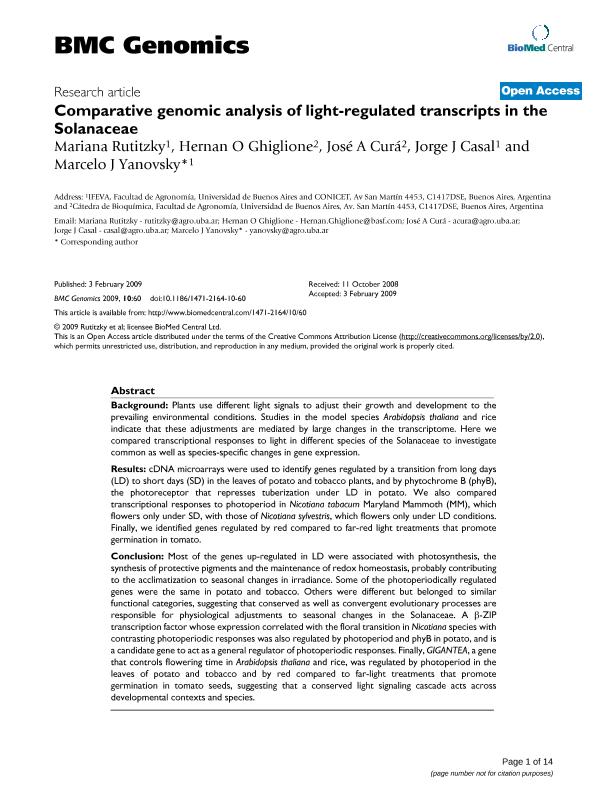Mostrar el registro sencillo del ítem
dc.contributor.author
Rutitzky, Mariana

dc.contributor.author
Ghiglione, Hernán O.
dc.contributor.author
Curá, José Alfredo

dc.contributor.author
Casal, Jorge José

dc.contributor.author
Yanovsky, Marcelo Javier

dc.date.available
2017-11-15T20:41:36Z
dc.date.issued
2009-02
dc.identifier.citation
Rutitzky, Mariana; Ghiglione, Hernán O.; Curá, José Alfredo; Casal, Jorge José; Yanovsky, Marcelo Javier; Comparative genomic analysis of light-regulated transcripts in the Solanaceae; BioMed Central; BMC Genomics; 10; 2-2009; 1-14
dc.identifier.issn
1471-2164
dc.identifier.uri
http://hdl.handle.net/11336/28295
dc.description.abstract
BACKGROUND: Plants use different light signals to adjust their growth and development to the prevailing environmental conditions. Studies in the model species Arabidopsis thaliana and rice indicate that these adjustments are mediated by large changes in the transcriptome. Here we compared transcriptional responses to light in different species of the Solanaceae to investigate common as well as species-specific changes in gene expression. RESULTS: cDNA microarrays were used to identify genes regulated by a transition from long days (LD) to short days (SD) in the leaves of potato and tobacco plants, and by phytochrome B (phyB), the photoreceptor that represses tuberization under LD in potato. We also compared transcriptional responses to photoperiod in Nicotiana tabacum Maryland Mammoth (MM), which flowers only under SD, with those of Nicotiana sylvestris, which flowers only under LD conditions. Finally, we identified genes regulated by red compared to far-red light treatments that promote germination in tomato. CONCLUSION: Most of the genes up-regulated in LD were associated with photosynthesis, the synthesis of protective pigments and the maintenance of redox homeostasis, probably contributing to the acclimatization to seasonal changes in irradiance. Some of the photoperiodically regulated genes were the same in potato and tobacco. Others were different but belonged to similar functional categories, suggesting that conserved as well as convergent evolutionary processes are responsible for physiological adjustments to seasonal changes in the Solanaceae. A beta-ZIP transcription factor whose expression correlated with the floral transition in Nicotiana species with contrasting photoperiodic responses was also regulated by photoperiod and phyB in potato, and is a candidate gene to act as a general regulator of photoperiodic responses. Finally, GIGANTEA, a gene that controls flowering time in Arabidopsis thaliana and rice, was regulated by photoperiod in the leaves of potato and tobacco and by red compared to far-light treatments that promote germination in tomato seeds, suggesting that a conserved light signaling cascade acts across developmental contexts and species
dc.format
application/pdf
dc.language.iso
eng
dc.publisher
BioMed Central

dc.rights
info:eu-repo/semantics/openAccess
dc.rights.uri
https://creativecommons.org/licenses/by-nc-sa/2.5/ar/
dc.subject
Transcriptome
dc.subject
Solanacea
dc.subject
Potato
dc.subject
Tomato
dc.subject.classification
Otras Ciencias Biológicas

dc.subject.classification
Ciencias Biológicas

dc.subject.classification
CIENCIAS NATURALES Y EXACTAS

dc.title
Comparative genomic analysis of light-regulated transcripts in the Solanaceae
dc.type
info:eu-repo/semantics/article
dc.type
info:ar-repo/semantics/artículo
dc.type
info:eu-repo/semantics/publishedVersion
dc.date.updated
2017-09-29T16:44:47Z
dc.identifier.eissn
1471-2164
dc.journal.volume
10
dc.journal.pagination
1-14
dc.journal.pais
Reino Unido

dc.journal.ciudad
London
dc.description.fil
Fil: Rutitzky, Mariana. Consejo Nacional de Investigaciones Científicas y Técnicas. Oficina de Coordinación Administrativa Parque Centenario. Instituto de Investigaciones Fisiológicas y Ecológicas Vinculadas a la Agricultura. Universidad de Buenos Aires. Facultad de Agronomía. Instituto de Investigaciones Fisiológicas y Ecológicas Vinculadas a la Agricultura; Argentina
dc.description.fil
Fil: Ghiglione, Hernán O.. Universidad de Buenos Aires. Facultad de Agronomía; Argentina
dc.description.fil
Fil: Curá, José Alfredo. Consejo Nacional de Investigaciones Científicas y Técnicas. Oficina de Coordinación Administrativa Parque Centenario. Instituto de Investigaciones en Biociencias Agrícolas y Ambientales. Universidad de Buenos Aires. Facultad de Agronomía. Instituto de Investigaciones en Biociencias Agrícolas y Ambientales; Argentina
dc.description.fil
Fil: Casal, Jorge José. Consejo Nacional de Investigaciones Científicas y Técnicas. Oficina de Coordinación Administrativa Parque Centenario. Instituto de Investigaciones Fisiológicas y Ecológicas Vinculadas a la Agricultura. Universidad de Buenos Aires. Facultad de Agronomía. Instituto de Investigaciones Fisiológicas y Ecológicas Vinculadas a la Agricultura; Argentina
dc.description.fil
Fil: Yanovsky, Marcelo Javier. Consejo Nacional de Investigaciones Científicas y Técnicas. Oficina de Coordinación Administrativa Parque Centenario. Instituto de Investigaciones Fisiológicas y Ecológicas Vinculadas a la Agricultura. Universidad de Buenos Aires. Facultad de Agronomía. Instituto de Investigaciones Fisiológicas y Ecológicas Vinculadas a la Agricultura; Argentina
dc.journal.title
BMC Genomics

dc.relation.alternativeid
info:eu-repo/semantics/altIdentifier/url/https://bmcgenomics.biomedcentral.com/articles/10.1186/1471-2164-10-60
dc.relation.alternativeid
info:eu-repo/semantics/altIdentifier/doi/https://doi.org/10.1186/1471-2164-10-60
Archivos asociados
